

St George-in-the-East Workhouse & Infirmary
St George-in-the-East Industrial School
and their chaplains
Much has been written about workhouses, and details of many of them can be found on this comprehensive site. Locally, the story overlaps with the activities of the Charity Organisation Committee. This page is about the institutions that were originally in, or founded by, the St George-in-the-East Union. The Whitechapel Union
was separate - serving the area that originally fell within the
parishes of St Mary Whitechapel, St Botolph Aldgate and Christ Church
Spitalfields - though there were two institutions in what later became
part of this parish:
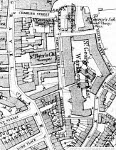

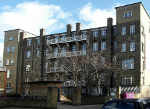
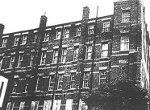 In 1836,
St George-in-the-East was constituted as a Poor Law parish
under the 1834 Poor
Law Amendment Act, administered by 18 elected Guardians; their office was at 6 Wellclose Square
(where Thomas Stone, the Superintendent Registrar for St George's
District, was also based following the introduction of civil
registration in 1837). The clerk had deal with the vast quantities of
paperwork that issued
from the central administration at Somerset House - in 1840, 2,000
orders and executive letters.They took over responsibility for the
workhouse
originally built in 1766 in Farthing Fields, between Prusom
Street and Princes
Street [now Raine Street] in Wapping, and authorised £2,000
for
its extension in 1844. Right are the male dormitories, now flats, on Penang Street, and Prusom Street in the early 20th century before slum clearance.
In 1836,
St George-in-the-East was constituted as a Poor Law parish
under the 1834 Poor
Law Amendment Act, administered by 18 elected Guardians; their office was at 6 Wellclose Square
(where Thomas Stone, the Superintendent Registrar for St George's
District, was also based following the introduction of civil
registration in 1837). The clerk had deal with the vast quantities of
paperwork that issued
from the central administration at Somerset House - in 1840, 2,000
orders and executive letters.They took over responsibility for the
workhouse
originally built in 1766 in Farthing Fields, between Prusom
Street and Princes
Street [now Raine Street] in Wapping, and authorised £2,000
for
its extension in 1844. Right are the male dormitories, now flats, on Penang Street, and Prusom Street in the early 20th century before slum clearance.
| The 'in-relief' budget in 1840 was £196.8.0 per 1,000 parish population -
nearly double that of Stepney, Whitechapel, Poplar, and Holborn, and
three times as much as that of Hackney and Bethnal Green. Only the
City unions within the wealthy Corporation area could rival St. George
in pounds spent per head. The parish was less out of line with its
neighbours in spending on outdoor relief, being in the middle range of
expenditure at about £75 per 1,000 population. St George topped the
poll of East London parishes for total poor pudget, both in the three
years prior to the Poor Law Amendment Act and in the years following. By 1842 the Poor Law Commission was confident that the Amendment Act was working to reduce the poor-rate burden as had been intended. There was a striking fall in poor relief up to 1840 in England and Wales, after the Act. In east London, the percentage fall in spending was most notable in Poplar and Holborn and lowest in St. George in the East and the City Corporation unions. The St George guardians were not however profligate on 'management costs'. While they paid their employees well, they employed fewer paid officers than other unions, and their spending on the salaries of union officers was substantially lower than their neighbours'. This could explain in part why the guardians were personally so heavily committed to the practical work that in other unions was delegated to the relieving officers and medical officers. [For example, they agonised over whether they should make personal visits to patients in mental asylums, and supported Stepney's call for a second county lunatic asylum, since Hanwell was too far away.] The parish had recognized in the first decade of the nineteenth century that the London docks were potentially major contributors to the poor-rate coffers and tried to impose a rate of 5 shillings in the pound. The outraged dock owners brought a High Court action to challenge the legality of such an exceptional charge, and won a reduction to half that amount. Nevertheless, the docks were St. George's 'cash cow' for the next twenty years, which in part may explain the guardians' 'freestyle' spending habits. Who were the benign guardians of St. George? The more obvious 'movers and shakers', the chairmen James Massingham, George Gibson, and Peter Rayner, are tantalizingly absent from trade directories and local lists of worthies. More of these guardians were churchwardens than in other districts and several served on one of the six tiny and famously inefficient local 'paving commissions' that operated in this one parish. Massingham, the inagurual chairman, was a manufacturing confectioner. Three guardians were governors of the local Raine's School Foundation. Perhaps it was the St. George in the East guardians that Sir J. P. Kay-Shuttleworth was thinking of when he complained that members of many London boards of guardians were 'Pickwickians' from the old parochial vestry; the vestrymen, he said, needed re-education. This is a most difficult task! The guardians of St George were re-educated into making economies only by the catastrophic docks recession of the 1860s; they then began to adopt the new Poor Law philosophy with greater enthusiasm. |
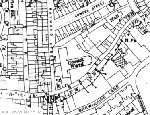
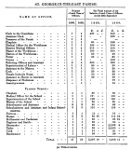 The Guardians opened a casual
ward for vagrants in Raymond Street, off Green Bank, in Wapping [right].
The Guardians opened a casual
ward for vagrants in Raymond Street, off Green Bank, in Wapping [right].
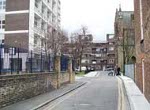
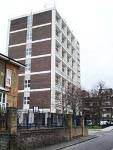 In
1871 an infirmary was added to the workhouse, with a nurse training
school in 1893. It was renamed an 'institution' rather than a
'workhouse' in 1913, but remained known locally as 'The House'. During
the First World War, when Bethnal Green Hospital was taken over for
treating wounded servicemen, its patients were transferred here. In
1925 St
George-in-the-East joined
Stepney Poor Law
Union; five years later the London County Council took over the
buildings and they became St George-in-the-East Hospital, with 406
beds; in 1948, under the NHS, it came under Stepney Group Hospital
Management Committee, and closed in 1956 (by then reduced to 208 beds), it was
temporarily used as a shelter for refugees following the
Hungarian uprising, and then demolished. Here are pictures of the site today.
In
1871 an infirmary was added to the workhouse, with a nurse training
school in 1893. It was renamed an 'institution' rather than a
'workhouse' in 1913, but remained known locally as 'The House'. During
the First World War, when Bethnal Green Hospital was taken over for
treating wounded servicemen, its patients were transferred here. In
1925 St
George-in-the-East joined
Stepney Poor Law
Union; five years later the London County Council took over the
buildings and they became St George-in-the-East Hospital, with 406
beds; in 1948, under the NHS, it came under Stepney Group Hospital
Management Committee, and closed in 1956 (by then reduced to 208 beds), it was
temporarily used as a shelter for refugees following the
Hungarian uprising, and then demolished. Here are pictures of the site today.|
To the memory of John Galwey LEEBODY M.B., Ch.B., F.R.C.S. Ed. Medical
Superintendent 1934-1946
who faithfully and devotedly served this hospital Write me as one that loves his fellow men |
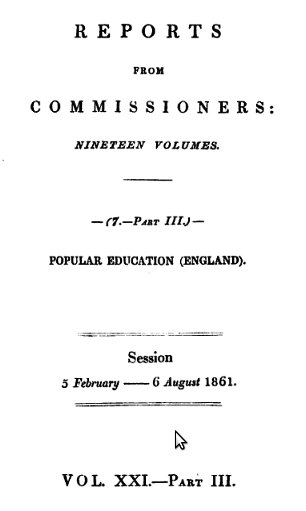 Industrial Schools
Industrial Schools
 In
1851 the Guardians built, at a cost of £35,000, industrial schools for
'pauper children' - 150 boys, 120 girls and 80
infants - on a 16-acre site at the junction of Shaftesbury Road and
Gipsy [now Green] Lane, Plashet, then in a semi-rural setting: compare
the 1894 map [left]. (See here for an early example of an industrial school in the parish.) Josiah Wilkinson's report for the 1861 Commission on The State of Popular Education in England includes these detailed comments about the school (p366ff). By 1871, it had 422 inmates. In due course, Kensington and Poplar Unions also sent children here.
In
1851 the Guardians built, at a cost of £35,000, industrial schools for
'pauper children' - 150 boys, 120 girls and 80
infants - on a 16-acre site at the junction of Shaftesbury Road and
Gipsy [now Green] Lane, Plashet, then in a semi-rural setting: compare
the 1894 map [left]. (See here for an early example of an industrial school in the parish.) Josiah Wilkinson's report for the 1861 Commission on The State of Popular Education in England includes these detailed comments about the school (p366ff). By 1871, it had 422 inmates. In due course, Kensington and Poplar Unions also sent children here.
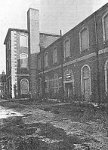 The
school closed in 1927; from 1928-83 it was used as a cinema - the Carlton [pictured],
then the ABC, and then the ACE - before it finally closed in 1983 [pictured 1970s]; the
site is now a
car park. (There were two other industrial schools in East Ham: St Nicholas' RC school, Gladding Road, Manor Park, opened in
1868 in the Manor House (one of the homes of the Fry family), closed in 1925 and the premises sold to the London Co-operative
Society; and St Edward's RC school, opened in
1875 at Green Street House (Boleyn Castle) - closed in 1906, it is now
part of West Ham FC grounds.)
The
school closed in 1927; from 1928-83 it was used as a cinema - the Carlton [pictured],
then the ABC, and then the ACE - before it finally closed in 1983 [pictured 1970s]; the
site is now a
car park. (There were two other industrial schools in East Ham: St Nicholas' RC school, Gladding Road, Manor Park, opened in
1868 in the Manor House (one of the homes of the Fry family), closed in 1925 and the premises sold to the London Co-operative
Society; and St Edward's RC school, opened in
1875 at Green Street House (Boleyn Castle) - closed in 1906, it is now
part of West Ham FC grounds.)| Salaries of Chaplains of Metropolitan Union Workhouses At the weekly meeting of the Marylebone board of directors and guardians, held on the l6th of October, for the purpose of considering the propriety of raising the salary of the Rev. P. Moody, the chaplain [Peter Moody, from Monmouthshire], from 150l. to 200l. per year, one of the directors, in support of his argument against such increase, read a letter he had received in answer to his inquiries upon the subject from the poor law commissioners, containing a list of the salaries of all the chaplains of the metropolitan union workhouses, which were as follow [sic]:– West Ham union workhouse, 120l.; Brentford, 80l. ; St. George in the East, 50l.; Hackney, 40l.; Hendon, 73l. 10s.; Holborn, 50l.; Kensington union, Chelsea workhouse, 40l.; Kensington workhouse, 40l.; Hammersmith workhouse, 30l.; Fulham workhouse, 30l.; City of London union, three chaplains, two at 150l. each, and one at 100l.; East London union, 100l.; West London union, 100l.; St Martin's-in-the-Fields, 100l.; Poplar, 60l.; Strand union, 90l.; Stepney union, Limehouse, 30l.; Mile-end workhouse, 30l.; Ratcliff workhouse, 30l.; Wapping workhouse, 30l.; Uxbridge union, 50l.; and Whitechapel union, 70l. Thus it will he seen that the entire sum paid for the services of twenty four clergymen does not exceed 1493l. 10s. per annum. |
 George Henry McGill,
incumbent at Christ Church Watney Street from 1854-67, was also
chaplain of St George-in-the-East workhouse for some or all of this
time. According to his 1861 model census, in his time the chapel seated 500. He campaigned for change on two related fronts:
George Henry McGill,
incumbent at Christ Church Watney Street from 1854-67, was also
chaplain of St George-in-the-East workhouse for some or all of this
time. According to his 1861 model census, in his time the chapel seated 500. He campaigned for change on two related fronts: | PRIVATE CHARITY AND THE POOR-LAW Sir, — The question with which your leading article of this day concludes, "Why does the Poor Law leave its work to be done over again by private hands?" is one which demands especial attention, at a time when the claims upon the resources of the charitable are so numerous and pressing, as your columns shew. People may well inquire how it is that the £750,000 annually raised in London for the relief of the poor fails to accomplish its object, and how it is that so many thousand persons are thrown in the winter season on the casual charity of refuges and other kindred institutions. Perhaps you will allow me briefly to state some of the causes which appear to me to have led to this state of things? The first and chief, if not the only cause, is the decided antipathy which exists on the minds of the poor to have recourse to the parish authorities at all, and especially to enter the walls of the workhouse. I have had an extensive experience of the feelings of the poorer classes, both in the country and in London, and there is nothing which I have found so universally prevalent among them as a horror and dislike of the so-called 'bastille', or Union-house. An inmate of such an abode is, in the eyes of the decent poor, a fellow-creature, and to be a 'workhouse brat' is regarded as a degradation. Now, there must be some substantial reason for this antipathy, otherwise it would never be so deep-rooted and so wide-spread as it is. If we can trace its origin and prevent its continuance we shall stop that preference which many now entertain of dying of starvation in their wretched homes, or even in the streets of London, rather than darken the door of the workhouse. It appears to me that this dislike of the workhouse flows from two distinct sources — one originating in the poor themselves, the other in the system on which the house is regulated. A simple every-day example will illustrate what I mean. Let us take the case of a widow with three or four children, left penniless by the death of her husband, a dock labourer perhaps, or a costermonger earning a precarious livelihood in the streets. Her support is gone, and she applies to the relieving officer for assistance. In most of the poorer parishes the rule is to allow about 5s. per week in such a case. She finds that she cannot live upon that wretched pittance, and applies for an increased allowance; the request is refused, and she is compelled, sorely against her will, to become an indoor pauper. As soon as she is admitted her children are taken from her, and she is placed in the receiving ward for a few days, very likely in company with some persons of abandoned character, whose bearing and language are often sufficient to outrage the feelings of any one who has lived a respectable life. She is afterwards removed to the common workroom, and made to pick oakum — not a very elevating employment — in the society of persons whose conduct is such as to lower her moral tone, and make her long even for the poverty-stricken freedom which she has lost. All sorts of tempers have to be borne with, all sorts of language to be listened to, till the heart is almost broken, and the spirits are weighed down with misery. The hatred of the workhouse is thus fortified and strengthened by the conduct of the poor themselves. But the chief cause of it, after all, is the mode in which the workhouse is, in accordance with the law, usually managed. It is to all intents and purposes a kind of prison. There is no exit allowed, except about once in three months for a solitary holiday. Few under the age of sixty years are allowed to go out on the Sunday, and all are liable to be searched both when they go out and when they return. The children are separated from their parents, and the parents from the children. All are subjected to an iron rule very different from that 'charity which thinketh no evil'. If the settlement of an inmate is doubtful, every effort is made to remove him to his legal parish, wherever that may be. He may be passed to the Land's End or to Ireland; to some place where he knows no one and no one knows him. It is true that there is always the option of taking his discharge, which means in many cases, especially in the winter months, running the risk of starvation. And this being the case, can we be surprised that the Poor Law leaves its work to be done by private hands? I think not. Its principles are too harsh even to be acceptable to the poor; its code is too rigorous even to relieve the most deserving, and till this is modified the evils which we now deplore will undoubtedly continue. But what is the remedy? Greater union and a more comprehensive system; greater discrimination and delicacy in the treatment of the in-door poor, and a considerable extension of out-door relief. It is in London that the weakness of the present law is chiefly seen, and this arises from the fact that it is the direct pecuniary interest of each board of guardians to throw the burdens of the poor from their own shoulders to those of others. Let this be remedied by equalising the rate over the whole metropolitan area, and then we should not hear of the refusals to admit the destitute into the houses provided for their accommodation in the wholesale way chat we now do. Let the respectable poor be dealt with more liberally and kindly than the profligate and vicious, and let those who can by honest means contribute to their own support out of doors be more generously aided in their efforts. Let the workhouse be deprived of its prison-like character, and then we shall find that, though the necessity for charitable appeals will not be utterly put aside, it will be materially diminished, and private hands will not be left to do that essential work which the law of the land has left undone. I am, Sir, your obedient Servant, An East-End Incumbent |
 William
Henry Foy was
Chaplain to St
George-in-the-East workhouse from 1868(?)-71. Trained at St Bees in 1848, he went as a
missionary chaplain to Gwalior, N W India [pictured].
He preached a
sermon in 1850 in Agra The
Christians of England the Watchmen of India - repeating it on his return to England in 1852 at the SPG's jubilee - and edited Claudius Buchanan's Christian
Researches in India: with the Rise, Suspension, and Probable Future of
England's Rule as a Christian Power in India (Routledge
1858) - though some reviewers complained he had omitted the most significant portions. He was curate-in-charge
of St Simon Bethnal
Green until 1855 or so, serving on the committee of the Operative Jewish Converts' Association), and as secretary of the Soldiers'
Infant Home:
William
Henry Foy was
Chaplain to St
George-in-the-East workhouse from 1868(?)-71. Trained at St Bees in 1848, he went as a
missionary chaplain to Gwalior, N W India [pictured].
He preached a
sermon in 1850 in Agra The
Christians of England the Watchmen of India - repeating it on his return to England in 1852 at the SPG's jubilee - and edited Claudius Buchanan's Christian
Researches in India: with the Rise, Suspension, and Probable Future of
England's Rule as a Christian Power in India (Routledge
1858) - though some reviewers complained he had omitted the most significant portions. He was curate-in-charge
of St Simon Bethnal
Green until 1855 or so, serving on the committee of the Operative Jewish Converts' Association), and as secretary of the Soldiers'
Infant Home:
|
The Philanthropist, and prison and reformatory gazette
1 June 1855 (no.1, new series) p3 The
Lancet 27 October 1855 p391 |
He then
became Principal of the Indian Civil
Service and Military College in Belsize
Park. However, in 1865 he was declared bankrupt, and legal proceedings
began against their eight infant children in relation to his wife
Eleanor Hannah's estate which he had mortgaged; when they married in
1848, they had given an undertaking to create a trust when she came of
age, but this was never done, and was held to be a fraud (full report in (1868) LR 4 Ch App 35).
Hence,
presumably, his becoming a workhouse chaplain. In this post, he
challenged the Guardians over their complicity with the licensing trade:
|
The
Temperance Record 3 October 1870 p483 Medical
Times & Gazette 14 January 1871 p57 1. That, having regard to the exposures of workhouse mismanagement and malversation of public moneys shown at the recent official inquiries held at St. George's-in-the-East and Kensington, conjoined with the facts elicited in evidence at the recent trial in the Court of Queen's Bench (Catch v. Shaen), it appears, in the opinion of this meeting, desirable to revise the Association for the Improvement of Workhouse Infirmaries, and for securing a radical reform in the administration of tho poor-laws. 2. With the view of taking such action as will convince the ratepayers of the Metropolis and the public generally that reform in our administrative arrangements is necessary for the removal of these manifold abuses, it is resolved that a Committee be now formed, with power to add to their number, for the purpose of framing such regulations as may be needed, and generally carrying out the objects of the Association. 3
That Mr. J.T. Dexter be appointed Hon. Secretary, pro tem.
Expressions of sympathy were received from several gentlemen who were
not able to be present at the meeting. PAUPERISM
MADE EASY |
On leaving his post he published in 1872 an 80-page booklet Poor-law
revelations in the interest of the ratepayers of the United Kingdom,
and on the behalf of the sick and deserving poor and also a sermon Is the pope God's vice-gerent? What saith the word of God? Perhaps
he had had enough of London, for he became Rector of
Barningham-Norwood, near Holt in Norfolk, a village with a
population of 31 (increased to 35 in 1885!) His bankruptcy was finally
resolved by a 'Special Resolution for Liquidation by Arrangement' (London Gazette 10 May 1889, p2593).
For
some time from 1870 Joseph Marychurch Vaughan, incumbent of St John the
Evangelist-in-the-East, was also licensed as a chaplain to the
workhouse, as was Edward J. Norman, curate at Christ Church Watney Street, in the 1880s.
Back to History | Back to St George-in-the-East Clergy 1860-1900